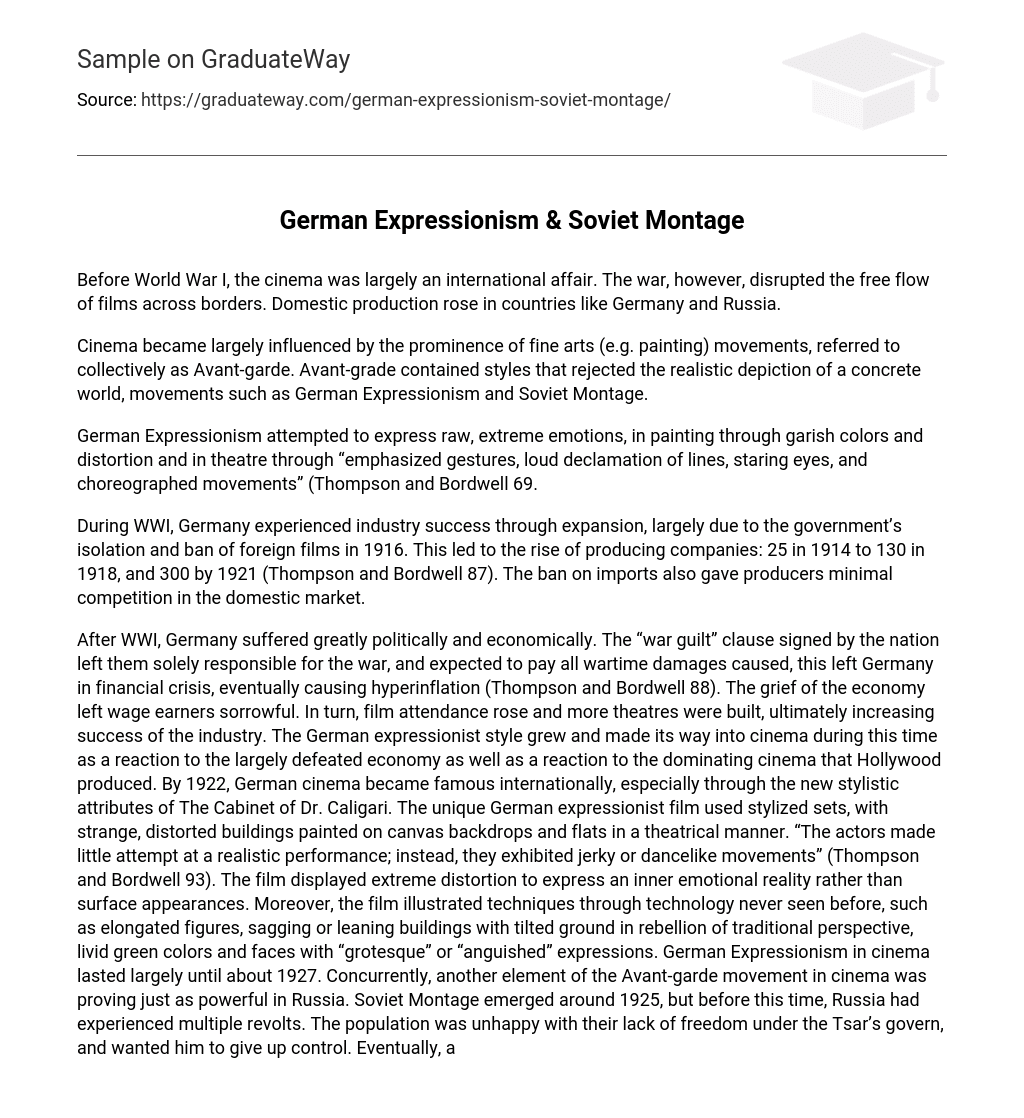Before World War I, the cinema was largely an international affair. The war, however, disrupted the free flow of films across borders. Domestic production rose in countries like Germany and Russia.
Cinema became largely influenced by the prominence of fine arts (e.g. painting) movements, referred to collectively as Avant-garde. Avant-grade contained styles that rejected the realistic depiction of a concrete world, movements such as German Expressionism and Soviet Montage.
German Expressionism attempted to express raw, extreme emotions, in painting through garish colors and distortion and in theatre through “emphasized gestures, loud declamation of lines, staring eyes, and choreographed movements” (Thompson and Bordwell 69.
During WWI, Germany experienced industry success through expansion, largely due to the government’s isolation and ban of foreign films in 1916. This led to the rise of producing companies: 25 in 1914 to 130 in 1918, and 300 by 1921 (Thompson and Bordwell 87). The ban on imports also gave producers minimal competition in the domestic market.
After WWI, Germany suffered greatly politically and economically. The “war guilt” clause signed by the nation left them solely responsible for the war, and expected to pay all wartime damages caused, this left Germany in financial crisis, eventually causing hyperinflation (Thompson and Bordwell 88). The grief of the economy left wage earners sorrowful. In turn, film attendance rose and more theatres were built, ultimately increasing success of the industry. The German expressionist style grew and made its way into cinema during this time as a reaction to the largely defeated economy as well as a reaction to the dominating cinema that Hollywood produced. By 1922, German cinema became famous internationally, especially through the new stylistic attributes of The Cabinet of Dr. Caligari. The unique German expressionist film used stylized sets, with strange, distorted buildings painted on canvas backdrops and flats in a theatrical manner. “The actors made little attempt at a realistic performance; instead, they exhibited jerky or dancelike movements” (Thompson and Bordwell 93). The film displayed extreme distortion to express an inner emotional reality rather than surface appearances. Moreover, the film illustrated techniques through technology never seen before, such as elongated figures, sagging or leaning buildings with tilted ground in rebellion of traditional perspective, livid green colors and faces with “grotesque” or “anguished” expressions. German Expressionism in cinema lasted largely until about 1927. Concurrently, another element of the Avant-garde movement in cinema was proving just as powerful in Russia. Soviet Montage emerged around 1925, but before this time, Russia had experienced multiple revolts. The population was unhappy with their lack of freedom under the Tsar’s govern, and wanted him to give up control. Eventually, a new communist government took over- one heavily interested in the development of filmmaking and he film industry. At the time, film equipment was not easily came by due to lack of revenue so students had begun to experiment with older film footage and Hollywood imports. They re-cut them and put them back together in different ways.
Thus, Montage was born as filmmakers began to radically change the meaning of image just through the editing and juxtaposition of them. Early montage films featured dynamic depictions of Tsarist period oppression and historical rebellion. Later, montage films were used to embody the new ideals of the Communist government so that they could be conveyed to the population. The new wave of films not only helped build revenue for the Soviet films industry, but was also relied on as the most powerful tool for propaganda and education toward a country that was mostly illiterate (Thompson and Bordwell 109-111). Sergei Eisenstein was one man who revolutionized Soviet Montage through his method of juxtaposition and “collisionary montage”. He would create sharp, volting, and even violent films through use of this method to create a universal effect of conflict, something the population would heavily relate to (Thompson and Bordwell 117-119). In his film, Strike (1925), the use of montage is clear. Spliced together images of men at work being shot down by machine guns juxtaposed by images of oxen being killed. The oxen were not on the location where the story takes place. The image was cut in for metaphorical purposes. Both avant-garde film movements proved heavily influential and significant globally. Although Expressionism and Montage in cinema both arose in times of political and economic hardships for both Germany and Russia, the cinematic arts did not suffer. Both movements have even influenced the dominating cinema of Hollywood.
CITATIONS
1. Thompson, , and Bordwell. Film History. 3rd. McGraw Hill, 42-127. Print.





